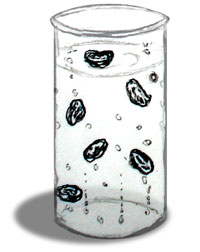
 |
 |
 |
 |
 |
 |
 |
 |
Experiment 1 • Experiment 3 • Experiment 4 • Experiment 5Experiment
2 Did experiment 2? Go to Experiment 3 I] Hypothesis Bubbles in the carbonated water cause suckelberries or raisins to rise and fall (dance). II] Materials needed
III] Procedure/Observation 
IV]
The Fizz in Suckelberry Soda F.Y.I. When you open a can of suckelberry soda, the noise you hear is produced by the carbon dioxide gas as it rushes out of the can.
________________________________________________________________ Experiment
3 I] Hypothesis Soap will break the surface tension* of water causing floating objects to either scatter to places where there is surface tension or to sink. II] Materials needed
III] Procedure/Observation
IV]
*What is the surface tension of water.
| |||||||
 |